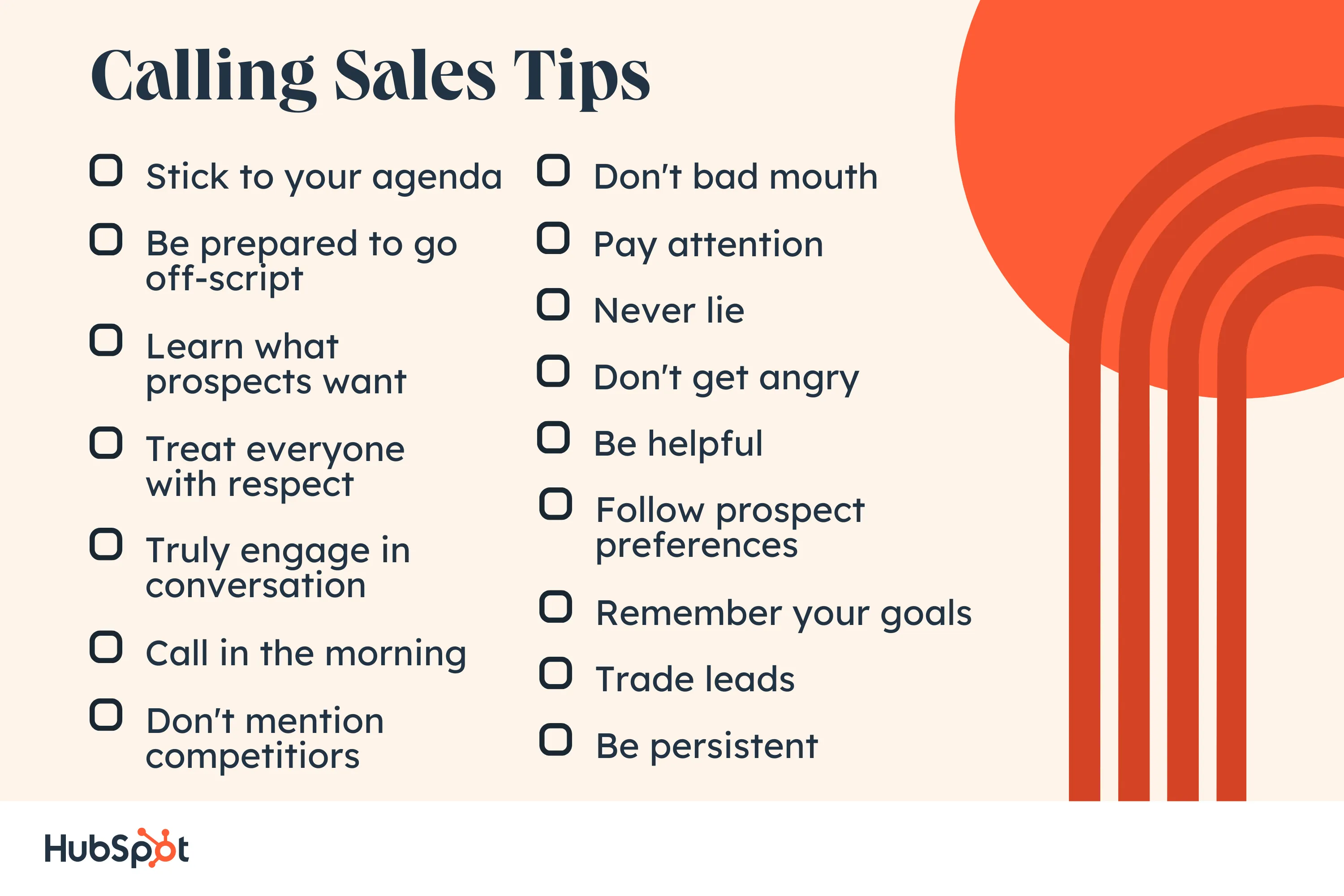Table of Contents
- Prospecting Sales Tips
- Email Sales Tips
- Calling Sales Tips
- Conversation Sales Tips
- Presentation Sales Tips
- Closing Sales Tips
- General Sales Tips
Prospecting Sales Tips

1. Monitor industry events that may trigger new demand, such as major hiring shifts, an executive leader change, or new industry legislation.
2. Before you reach out to a prospect, identify the specific problems they’re likely to be dealing with.
What we like: Researching your prospects is key to making a pitch that hits home. Your pitch should be tailored to each buyer’s pain points. The more you can personalize, the better your odds of success.
3.Narrow your audience: “When you focus your energy on targeting a narrower audience, your message can be more customized,” says digital strategist and entrepreneur Trish Saemann.
4. Schedule time for prospecting every day — even on the last day of the month or quarter.
What we like: This shows your dedication and perseverance, both to your team and to yourself.
5. In addition to traditional channels such as email, phone, events, and referrals, use social media to research new prospects. Of salespeople, 55% do, helping them build rapport and keep the top of their pipeline as full as possible.
Email Sales Tips

6. To get more engagement with your emails, keep your writing accessible and easy to understand.
Pro tip: Avoid unnecessary jargon or long blocks of text. You can discuss every aspect of what your product does during a demo or call. Your email is just a brief touch point.
7. Limit your email subject lines to seven words max — otherwise, they may be cut off when viewed on phones.
8. You may be tempted to use “Re:” in a subject line to increase open rates, but prospects are likely to promptly delete these messages after opening them.
9. If you’re trying to reengage a prospect who’s gone quiet, don’t guilt-trip them.
10. Emails that start with “just checking in” or “just following up” aren’t nearly as effective as those that include a reason for reaching out and a clear call-to-action.
11. Consider using videos to grab your prospect's attention and stand out in a crowded inbox.
What we like: Video is now the preferred method of media consumption, so take advantage of it and meet your prospects where they’re at. You may not be able to embed a video directly in an email, but you can create a gif with a play symbol that links to the full video.
12. To avoid the annoying back-and-forth of finding a time to meet, include a link to schedule a meeting directly on your calendar.
13. Send a follow-up email as soon as you get off the phone to ensure things don’t slip through the cracks.
14. Use spell-check or an editing tool like Grammarly to avoid embarrassing typos in your copy.
15. Keep track of your templates’ open and response rates. Then, drop your low-performing messages — and double down on the high-performing ones.
16. Think twice about using funky formatting or special fonts. They may seem fun, but more often than not, they’ll just make you look unprofessional.
17. Never send an email without including at least two personalized elements — and no, [prospect name] and [company name] don’t count.
What we like: Although email templates can help save you time, keeping things personalized allows you to make more meaningful contact with each prospect.
18. Write concisely. Rambling on and on can make you sound insecure, whereas clear, focused communication sends the message that you believe in yourself and the value of what you have to offer.
19. Emojis can be a great way to convey a more human, conversational tone — but don’t overuse them.
Calling Sales Tips

20. On a first discovery call, it’s important to balance sticking to your own agenda with addressing the pricing and product questions that prospects are likely to be most interested in.
21. Your prospects want to talk to a person, not a robot — so you can use a sales script as a starting point, but be prepared to go off-script as needed.
22. Try to get to the bottom of what your prospects want and what they may be thinking but not telling you.
Pro Tip: Databox CEO and Former HubSpot Sales Vice President Peter Caputa recommends bringing a “healthy skepticism and a willingness to ask incisive questions” into every sales conversation. He adds, “This is necessary to break down prospects’ walls and uncover the truth.”
23. Treat everyone with respect: Just because someone isn’t a final decision-maker or senior executive doesn’t mean you should dismiss them or their authority.
24. “To ensure you’re truly engaged in every conversation, pretend each call you have is the first with that customer,” advises sales strategist Babette Ten Haken.
25. Research shows that people tend to be more honest in the mornings, so if you’re struggling to pin down a flakey prospect, try scheduling an early-morning call.
26. If you also work with your prospect’s competitors, don’t advertise that in your pitch — after all, your prospect wants to be better than their competition, not exactly the same.
27. Never bad-mouth your competitors to a prospect — and if your competitors do something well, say so openly. This sends the message that you’re both honest and confident about your own value.
Pro tip: Keep a close eye on your competition and note what their strong points are. You can then tailor your approach to emulate their best practices.
28. Pay attention. According to a recent survey of 1,000+ global sales pros, being attentive and engaged is the number one most effective strategy for building rapport with prospects.
29. Never lie. “As a salesperson,” sales expert Jim Keenan explains, “truth is your greatest asset, because it builds trust.”
30. If a prospect criticizes you, don’t get angry or defensive — that’ll only make them dig in their heels, while humility and grace are more likely to get them to come around.
31. To maintain a friendly and helpful attitude, try picturing yourself sitting on the same side of the table as your prospect.
Best for: Keeping the prospect’s good in mind, especially if they’re difficult for you to work with.
32. Defer to your prospect’s communication preferences: If they clearly prefer email over phone calls (or vice versa), then go with it.
33. When motivation flags or you find yourself reluctant to get on (yet another) call, remind yourself of your financial, career, or personal goals.
34. Trading leads with another salesperson can be a great way to get out of a sales slump: You’ll feel less pressure to perform, and it could be a fun change of pace (as long as you agree in advance who’ll work the deal long-term if the prospect ends up moving forward).
35. Be persistent and don’t give up on a prospect just because you don’t get an immediate response.
Pro Tip: B2B call center expert Jeff Kalter argues, “A baseball team won’t win the game if they only try to hit the ball once. The same is true for you. If you only call leads once, you’re highly unlikely to make the sale.”
Conversation Sales Tips

36. Sales trainer and co-author of Your Successful Sales Career Len Foley speaks to the power of genuine curiosity, reminding salespeople to “get fascinated with your prospect.”
37. Maintain a 2:1 ratio of info to feedback: For every two pieces of information you give your prospect, ask a question confirming you’re on the right track.
What we like: This tip ensures you’re engaged in a conversation, not just sales pitching. By asking questions you can also put your active listening skills to use.
38. Show, don’t tell: “The moment [you’re] tempted to tell the buyer what ‘he needs to do’... offer a story about a peer of the buyer [instead],” suggests Mike Bosworth, author of Solution Selling and What Great Salespeople Do.
39. An easy-to-follow success story is dramatically more effective than a long or meandering one — so when it comes to storytelling, keep it short and sweet.
40. When offering a counterpoint, using the word “and” instead of “but” can help you sound like you’re agreeing with your prospect, taking them off the defensive and making them more amenable to your position.
41. Don’t rush to fill silences. These quiet moments give prospects a chance to process information and make a sales pitch feel more conversational.
42. To boost your prospect’s subconscious sense of connection with you, identify the specific words they use and use those same words in your own speech.
43. Flattery works. Complimenting a prospect on a recent company achievement or personal success can go a long way to cementing your relationship.
Pro tip: Don’t overdo it. People can tell when you’re just buttering them up, so be sincere and specific in your praise.
44. Enthusiasm can be a positive, but too much can backfire. Avoid an excessively boisterous tone, and limit your use of words like “awesome,” “fantastic,” and “amazing.”
45. A recent report identified “good listening skills” as the most important skill for sales leaders — so make sure you’re taking the time to listen when engaging with prospects.
46. To show you’re listening, paraphrase what your prospect says back to them with a phrase like, “What I hear you saying is…”
47. Harvard professor and former HubSpot CRO Mark Roberge speaks to the importance of establishing urgency: “In my experience,” he reflects, a “sense of urgency is best addressed right after the goal-setting phase of the discovery conversation. Once goals are established, explore why it’s critical for the prospect to address the pain now.”
Presentation Sales Tips

48. If you’re feeling tired or checked out, listening to an energizing song before you make calls can help you get your head in the game and come across as more upbeat and engaged.
49. Only present solutions that are relevant to the prospect (even if that means leaving a really popular feature out of your presentation).
What we like: By focusing only on the relevant solutions, you show your prospect that you understand them and want to help meet their needs. This demonstrates that you have their best interest in mind.
50. Your prospects don’t care about your product’s bells and whistles — instead, highlight how these features translate into real value for the buyer.
51. Don’t be afraid to ditch your presentation agenda if the prospect wants to focus on a different topic. This is all about putting the customer first, which is the heart of inbound marketing.
52. If you’re using a presentation deck, don’t let it become a distraction, notes SinglePlatform CEO and co-founder Wiley Cerilli: “Successful salespeople are trained to capture and manage customers’ attention. You don’t want to give authority away to the deck that’s behind you.”
53. Less is more: The longer your presentation lasts, the less impact you’re likely to have.
Pro Tip: Practice your presentation ahead of time so you know your message, are confident in what you’re saying, and can present it without rambling or being repetitive.
54. Writing down a prospect’s objections in real time shows that you’re really paying attention (plus, it’ll help you address their concerns more effectively).
55. Rather than trying to force a prospect through your funnel, adapt to their buying process.
56. Come up with a target next step to come out of the presentation (a follow-up meeting, a product trial, purchase terms) — along with several alternatives in case it’s rejected.
57. Don’t overpromise. It may win you the deal today, but it won’t be worth the unhappy customers you’ll face tomorrow.
Best for: Creating a flywheel, which relies on bringing in long-term, happy customers.
58. When demoing your product, focus on the key features relevant to your prospect, rather than whizzing around a complex interface or diving into every detail.
Closing Sales Tips
59. Don’t procrastinate: More than one in five sales professionals say the biggest reason prospects back out of deals is because the sales process takes too long.
60. To either get a “yes” or surface a prospect’s remaining objections, ask them, “If we offered you the product at this price, would there be any reason you wouldn’t do business with our company?”
Best for: Making sure your prospect has no more lingering doubts or reservations.
61. Avoid manipulative closing techniques, as most prospects today are sophisticated enough to recognize them and walk away.
62.Freemium and free trial offers can be a great way to get to yes, with 90% of salespeople who use these options reporting that they are “moderately to extremely effective at turning prospects into paying customers.”
What we like: This option allows your prospects to actually experience the value your product has to offer. Allow the product to speak for itself.
63. Go into negotiations with a few non-monetary concessions to offer, so you can negotiate on terms other than price.
General Sales Tips

64. To boost your momentum and confidence when you’re in a sales slump, set yourself a few small, achievable goals.
65. Define a personal “sales mission statement” and use it to foster a more deliberate decision-making process.
66. Don’t sell something you don’t believe in.
Pro tip: “If you believe that all you have is your transaction, you’ll never get there,” writes Keith Ferrazzi, author of Never Eat Alone. But if you truly believe in what you’re selling, you’ll “know that you’re inviting people into what is absolutely a beautiful (and long-term) relationship.”
67. Address complaints promptly and directly. Ignoring them or being roundabout will only turn prospects away.
68. Your sales manager can be an incredible resource, but you need to ask the right questions to grow as a sales rep.
Pro tip: Don’t avoid the hard questions, like “Why do you think we lost this deal?”
69. “Attend call reviews,” says Michael Pici, director of sales at HubSpot. “If you‘re not running or attending call reviews, you’re missing a huge opportunity to improve your sales performance.”
70. Never stop learning: Keep your knowledge of the product up-to-date, role play challenging conversations, and read industry news regularly.
Best for: Staying engaged in your career and upping your sales game.
71. Research shows the top salespeople are resilient, empathetic, and ambitious, so focus on honing those traits in yourself.
72. Forget “Always Be Closing” — your mantra should be “Always Be Helping.”
73. Always go the extra mile: Even if it’s the last day of the month, even if you’ve already hit your quota, keep calling, emailing, and scheduling meetings.
74. To stay on track when you’re feeling demotivated, set yourself clear goals — and stick to them.
Pro Tip: Ask a colleague to help you hold you accountable to your goals, and you can do the same for them.
75. Protect your time: You only have so many selling hours in the day, so avoid distractions and use your work hours wisely.
76. Productivity is important — but you can’t be productive if you’re burnt out. So don’t forget to prioritize work-life balance!
77. Seek out team members who will motivate you to improve and encourage you to keep going when you're feeling down.
What we like: This is where the “team” aspect of your sales team comes into play. Make sure you’re supporting one another so that everyone succeeds.
78. Learn from the best: Take the top-performing salespeople at your company out for lunch and ask for their advice.
79. A great manager, coach, or mentor can make a world of difference — so invest in cultivating these relationships.
80. Sales pro Jeff Kalter emphasizes the importance of adaptability: “Because every buyer is different, you can’t set your sales cadence in stone. Instead, monitor prospects’ interests and how they interact with your brand. Downloading a white paper, for instance, is entirely different than a contact request.”
81. Embrace new technology: For example, more than two in three salespeople say that AI and automation tools are changing how they plan to sell.
Best for: Freeing up sales reps to make more human connections with prospects.
Getting Started
When it comes to sales, everyone has their own style. These tips aren’t one-size fits all. Start experimenting to see what works best for you. Or even better, team up with a teammate and tackle these tips together.

